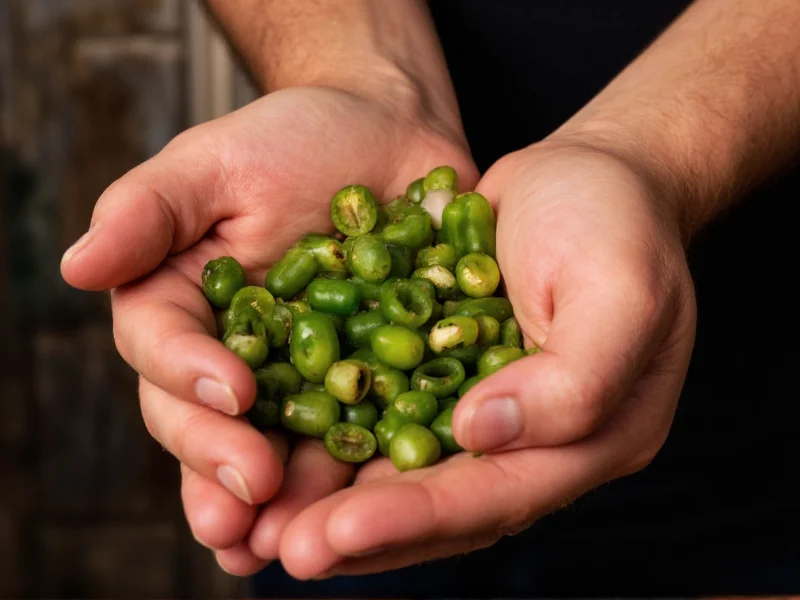"Jalepeno hands"—more accurately spelled jalapeño hands—describes the uncomfortable burning sensation experienced when handling jalapeño peppers without protection. This condition affects home cooks, chefs, and gardeners who come into direct contact with capsaicin, the oily compound responsible for peppers' heat. Understanding why do jalapeños burn your hands and how to manage this reaction is essential for anyone working with hot peppers.
What Causes Jalapeño Hands?
Jalapeño hands occur due to capsaicin, a lipophilic (oil-loving) chemical found in chili peppers' placental tissue. When you handle peppers, capsaicin transfers to your skin and binds to TRPV1 receptors—nerve endings that detect heat and pain. This triggers a burning sensation identical to actual thermal burns, though no physical damage occurs. The misconception that "jalapeños actually burn your skin" is false; it's a neurological response to capsaicin exposure.
Symptoms and Duration
Symptoms typically appear within minutes of contact and include:
- Burning or stinging sensation on fingertips and palms
- Redness without blistering (unlike thermal burns)
- Increased discomfort when touching eyes or face
- Potential temporary numbness after initial burning phase
How long does jalapeño burn last? Most cases resolve within 30 minutes to 4 hours with proper treatment. Severe reactions may persist up to 24 hours, especially with prolonged exposure to extremely hot peppers like habaneros or ghost peppers.
Immediate Relief Methods
When experiencing jalapeño hands burning sensation, act quickly with these evidence-based approaches:
| Remedy | Effectiveness | Application Method |
|---|---|---|
| Soap and water | Moderate | Wash thoroughly with dish soap (cuts oil) |
| Cold milk or yogurt | High | Soak hands for 10-15 minutes (casein binds capsaicin) |
| Cooking oil | High | Apply then wipe off (dissolves capsaicin oil) |
| Alcohol-based sanitizer | Moderate | Rub on affected areas (dissolves oils) |
| Water alone | None | Avoid—spreads oil and worsens burning |
Preventing Jalapeño Hands
Preventing jalapeño hands when cooking requires understanding capsaicin's properties. Since this compound is oil-based and water-resistant, standard handwashing won't prevent transfer. Implement these strategies:
- Wear nitrile gloves (latex offers poor protection against oils)
- Apply cooking oil to hands before handling peppers
- Use dedicated cutting boards for hot peppers
- Avoid touching face during food preparation
- Wash tools and surfaces with soapy water immediately after use
When to Seek Medical Attention
While jalapeño hands home remedies typically resolve symptoms, consult a healthcare provider if you experience:
- Severe swelling or blistering
- Burning lasting more than 24 hours
- Accidental eye exposure causing vision changes
- Signs of infection in affected areas
These indicate possible chemical burns requiring professional treatment. Never use harsh chemicals like bleach to remove capsaicin—this worsens skin damage.
Common Misconceptions
Several myths persist about treating jalapeño hands:
- "Water will wash it away" – Water spreads capsaicin oil, intensifying the burn
- "The burn means skin damage" – It's a neurological response, not actual tissue damage
- "Only hot peppers cause this" – Even mild peppers contain capsaicin in varying concentrations
- "Vinegar helps" – Acidic solutions don't neutralize capsaicin effectively
Special Considerations for Sensitive Skin
Individuals with eczema, psoriasis, or other skin conditions experience more intense reactions. For jalapeño hands relief for sensitive skin, prioritize oil-based removal methods and follow with fragrance-free moisturizers. Consider using pepper corers instead of direct handling to minimize exposure.
FAQs About Jalapeño Hands
How do you get rid of jalapeño hands fast?
Immediately wash hands with dish soap and cold water, then soak in whole milk or apply vegetable oil. The casein in milk binds to capsaicin, while oil dissolves the compound. Avoid hot water, which opens pores and increases absorption.
Can jalapeño hands cause permanent damage?
No, jalapeño hands don't cause permanent damage. The burning sensation results from temporary nerve activation, not tissue destruction. Symptoms typically resolve within hours with proper treatment. Permanent damage only occurs with severe chemical burns from industrial capsaicin concentrations.
Why do my hands still burn after washing jalapeños?
Water alone doesn't remove capsaicin because it's oil-based. If you washed with just water, the oil remains on your skin. Use soap (which cuts oil) or oil-based removers like milk or vegetable oil. Residual burning often means capsaicin transferred to other surfaces you touched after handling peppers.
Does vinegar help with jalapeño burns?
No, vinegar isn't effective for capsaicin burns. Since capsaicin is alkaline, some believe acid neutralizes it, but vinegar doesn't break down the oil effectively. Dairy products (milk, yogurt) or oils work better by binding to or dissolving capsaicin. Vinegar may even irritate already sensitive skin.
Can you build tolerance to jalapeño hands?
Yes, repeated exposure can build temporary tolerance as nerve receptors become desensitized. However, this isn't recommended as a prevention strategy because it requires repeated painful exposure. Professional chefs typically use gloves consistently rather than relying on desensitization, which wears off when exposure stops.











 浙公网安备
33010002000092号
浙公网安备
33010002000092号 浙B2-20120091-4
浙B2-20120091-4